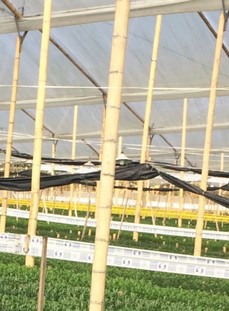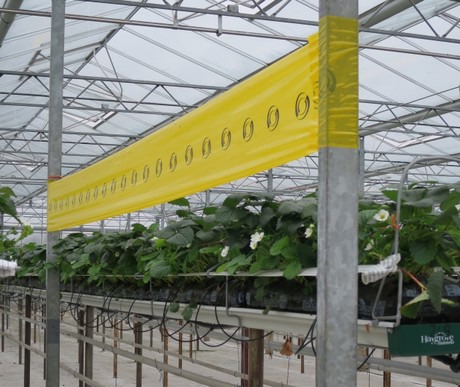Dr. Clare Sampson, Horticultural Development Manager at Russell IPM, explained that there is also an increase in the use of the traps to reduce insecticide treatments, especially in floriculture crops. "Flower growers in countries like Colombia for example, are looking at alternative ways to significantly reduce the number of pesticide treatments used in order to manage pesticide resistance and reduce pesticide residues."

Sampson said that the traps can be used within both biological and chemical programs. "We always advise growers to use traps as part of a program. For a crop with low pest numbers, the rolls can be enough, but with moderate or high pest numbers, the rolls will not be enough on their own and they must be used in combination with other control methods, such as biological systems or with a chemical program."
Yet, Sampson explained that it is important to use roller traps from the very start of the crop to delay the build-up of pest numbers. "When used as a preventative measure, 2016 trials showed that Russell IPM yellow roller traps can reduce whitefly numbers by as much as 80-90 % and blue patterned thrips traps reduced thrips numbers in flowers by 50-80%. However, when populations increase other measures will be needed for an immediately knock down treatment, as the traps will only catch adults and not larvae."
Which color?
While it might look like a basic tool, it is important to know the difference between the various types of roller traps that are available on the market. There are blue tapes, yellow tapes, white tapes and also patterned versions. Each one is designed for a different purpose and pest. Sampson explained that various trials and ongoing development takes place in order to optimize the color wavelengths and patterns on the traps in order to increase the trap catch.
This is because the color and the patterns on the rolls are a complicated story. Russell IPM spends hours in research an trials to find out which specific colors are the most effective for certain pests. It is not just blue or yellow, but the key lies in the specific wavelength of the blue or yellow color. "You need a very specific colour wavelength for certain pests to be attracted to the trap, but we have also found that the brightness of the colour also affects attraction "
"Our Optiroll blue rolls for example are specifically attractive to the western flower thrips, Frankliniella occidentalis, but will not attract whiteflies. If you want to catch a wider range of pests with one trap, including whiteflies and thrips, then yellow is the best option. White rolls are favoured by some Columbian growers whose flowers are attacked by several species of thrips. As white rolls can also attract some natural enemies, they are less suited to crops where biological pest control is the main method of control”.

Yellow traps (Yellow Optiroll, Actiroll)
Russell IPM has several kinds of yellow roller traps available. One of them is the yellow ActiRoll, designed for whitefly, leaf miner and aphid management. The yellow color of the tape has a specifically selected wavelength to enhance the attraction of whiteflies, while still attracting leaf miners, aphids and thrips. Yet, the wavelength of the trap is not attractive to bees, so the rolls can be combined with bumble-bee pollination. Due to the elasticity Actiroll is very suitable for greenhouses, as it can be stretched flat between poles and bays of the greenhouse structure. A second roll is yellow Optiroll, which has a similar performance to Actiroll but is made of a tear-resistant polymer, and can withstand warm climates, glasshouse or outdoor use and long season crops.
Yellow patterned traps (Yellow Optiroll super)
The Optiroll tape also comes with a black patterned design, which has proved particularly effective in warmer climates. The patterns of the Optiroll Super tape, create additional visual attraction to catch more insects. According to Russell IPM, the addition of a specific pattern to Optiroll yellow can catch twice as many whiteflies as plain Optiroll. The plain and patterned Optiroll are strong rolls that are suitable for catching whiteflies in both greenhouse, high tunnel and open field environments.
Click here for more information on Yellow Optiroll
 Blue traps for Western Flower Thrips (Blue Optiroll, Optiroll super, Optiroll super plus)
Blue traps for Western Flower Thrips (Blue Optiroll, Optiroll super, Optiroll super plus)If you are dealing with an invasion of Western Flower Thrips, you are advised to use the blue sticky trap to give the bugs the blues.
Russell IPM Optiroll blue rolls have been tested rigorously over several seasons, on different crops and in various countries. Repeated large-scale trials showed that the rolls consistently reduce adult thrips numbers by 50-80%.
Besides the standard Blue Optiroll, growers have the option of a white pattern on the blue traps (Optiroll super), that typically increases the trap catch of Western Flower Thrips and some other thrips species, such as Thrips major, by about 25 %.
There is also a Super Plus version available of this blue patterned tape, on which the Western flower thrips aggregation pheromone has been added to further enhance the trap catch. Our trials also showed that the addition of the western flower thrips aggregation pheromone, that attracts both males and females, enhances the trap catch of western flower thrips further, by 30-100%."
“The blue rolls are a safe to use and can be integrated with key beneficial species such as Orius and bumble bees. Combining roller traps with natural enemies has provided robust thrips control in different crops and countries, resulting in clean produce, reduced insecticide use and increased profits”.
Click here for a leaflet with more info on Blue Optiroll
For more information:
Russell IPM
Contact marketing@russellipm.com to get in contact with the distributor in your country.
